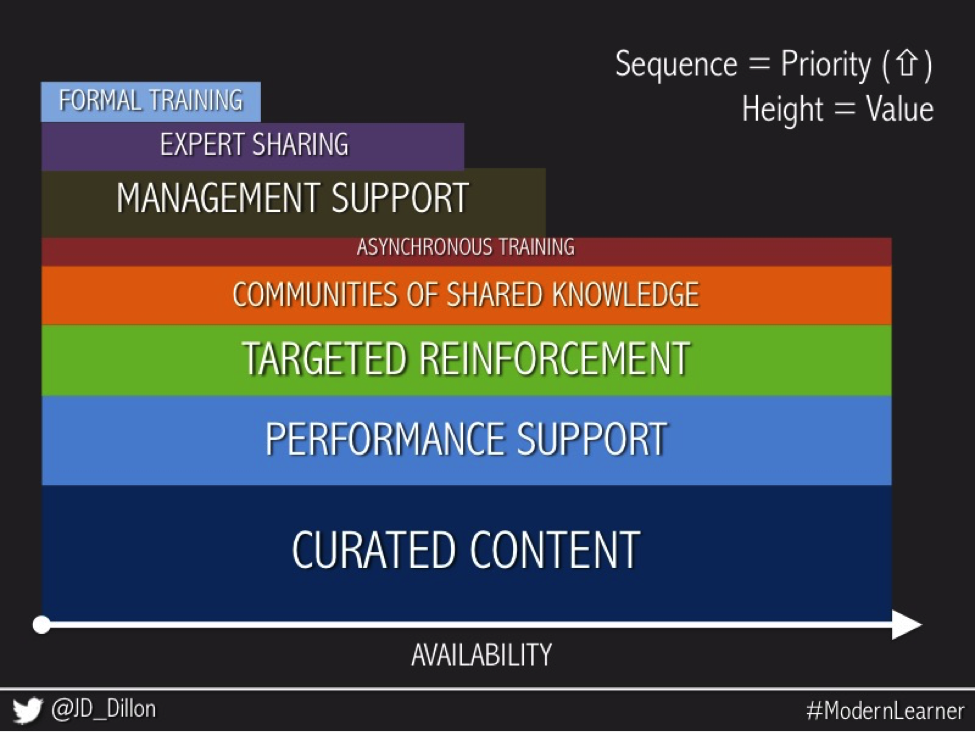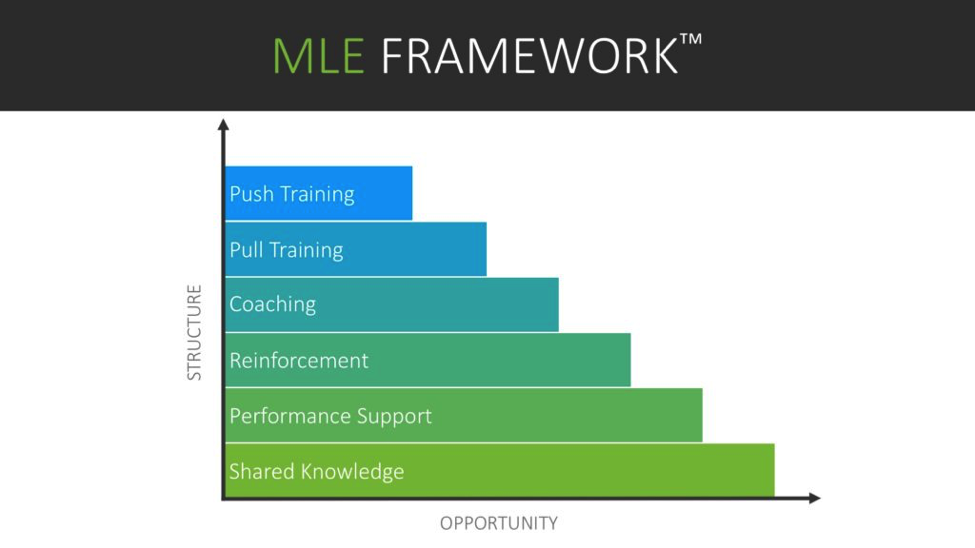Moments have been a central theme for me lately. In my "Modern Learning in Six Words" column last month, I referenced Bob Mosher and Conrad Gottfredson’s concept of thinking about workplace learning in terms of moments. I have also had plenty of insightful and inspirational moments of my own during the past few months when speaking with L&D pros in a range of industries from around the world. Spoiler: We’re all facing similar challenges to our L&D perspective!
I was excited to speak at the Australian Workplace Learning Conference in June. To get back from Sydney, I had to take a flight to Los Angeles that was about 14 hours. When you’re sitting in the same spot for that long watching people inexplicably fail to figure out how to open the door to the airplane’s restroom (PUSH), you have plenty of time to reflect. I got to thinking about my career so far—specifically how I have become so lucky as to have the chance to travel halfway around the world to share my ideas.
As an L&D professional with no associated training, my approach has been shaped almost entirely by 20 years of practical experience in operations, human resources, and training. Sure, I read books. I listen to many, many podcasts. And my personal learning network (PLN) continues to inform my perspective. But in real life there have been distinct moments—good and bad—that challenged me to rethink how I approached my work. I often include these moments in my presentations, and they continue to drive my everyday decisions.
Here are six moments that shaped how I view the role of learning in the modern workplace:
My First Job
I was afraid to talk to people growing up. That’s mildly hilarious given my current profession, but it was downright paralyzing for 18+ years. So then why did I ever think that a cashier position in a high-volume movie theater was a good first job? I was extremely nervous from the start. The POS was confusing. I had never handled money before. Oh yeah, and that whole fear of people thing …
But I’m happy to tell you that things went very well. I still remember how supported I felt the first time I practiced on a register. My trainer ran me through scenarios and provided great feedback along the way. It wasn't an online simulation. It wasn't in a classroom. It was in the real operational environment, but in a section that was restricted for training. His help did more than just make me more knowledgeable. This was the moment when I realized how good on-the-job support can bolster your confidence.
A Bad Welcome
I started with my next company five years later. This time, I came in with solid experience. I had been promoted several times over the years and dealt with plenty of challenging situations. I was still a manager with that company, but I had also picked up a part-time gig on the weekends. It was a way to try something new, but with less stress and responsibility than my full-time job. That said, this was still only my second employer. It was also a very different environment. I was excited but also quite nervous.
"Dillon?" That's all my trainer said as he waved his hand at me from across the room as a signal to follow him. No introduction. No welcome. He didn't even use my first name. He proceeded to have three or four conversations with people we encountered on the way to our location before really talking to me. As a new employee, I felt ignored. As a manager with years of customer service experience, I felt annoyed. This was not how anyone should be treated on their first day. Or any day. This moment reminded me how important it is to make sure the people you work with feel supported from Day One.
What Comes Next?
A few years later, I was an L&D manager within that company. My team focused on designing and delivering customer service training. We completed our big project, during which we delivered a brand new class to every employee. Then we flipped into sustainment mode, delivering the class to new employees after their first few weeks on the job. Everything was going well. People liked the class. I'd been promoted along the way. Good stuff all around!
But once all of the hype and energy around the project faded, something started to gnaw at me. I couldn't help but wonder what our impact on the organization really was, and what that meant for our value. Our survey scores were great. Executives were pleased. It felt like we were doing good work. But something was missing. So I asked my boss: What comes next? There was no answer. We just kept chugging along, doing the same thing ... until most of the team was laid off and I was transferred to a different role. This moment showed me that business impact is all that matters, regardless of how much people like what you’re doing.
Wikipedia, But For Here
Another company. Another L&D management role. This time, I was in a contact center. My team was chugging along, delivering loads of classroom sessions and building click-next-to-continue eLearning modules by the dozens. I was hired to bring a new perspective to the team, but stakeholder demands had us pinned down. We wanted to try new things, but we just didn't have the time or resources.
Then we lost our primary eLearning developer. I stepped in to finish his Captivate work. When I went hunting for source material on the company intranet, I couldn't find anything. I figured I just didn't know where to look because I was new, so I asked around. No one could find anything. Not only that, but I noticed how many training requests seemed related to missing reference information. In this moment, I recognized that the foundation of workplace learning was shared knowledge—not training. The ability to quickly solve problems that arise in the moment, not go to a class or click through an eLearning.
I went to my boss and suggested, "What if we just build something like Wikipedia, but for here?" She wrote "Wikipedia" on a Post-it note and stuck it to her monitor. It stayed there for two years until we started building the knowledge sharing mechanisms that would fundamentally change how the organization approached training.
Yet Another Layoff
A few weeks after I asked the Wikipedia question, management laid off almost half of the division’s employees. I didn't lose my job. I didn't know many people who did because (strangely) L&D wasn't really hit. And this wasn't my first (or last) corporate layoff experience. But I was personally impacted. I felt like it was my fault.
I couldn't have stopped the layoff from happening. But I should have known it was coming. My work should have reflected the challenges we were facing as a business. But instead, we were just taking orders and making sure everyone liked our work. The layoff was clearly the fault of management, but internally I took some of the blame. This moment reinforced the importance of keeping L&D strategy firmly connected to business priorities. We should be fighting for the same results as our partners and stakeholders. If they succeed, we succeed. If they fail, we fail.
A Whiteboard Drawing
Fast-forward a few more years to another new company. I was invited to an all-day session with a new client. They were looking for help developing a new vision for L&D and couldn't quite see how all of the pieces fit together. Our project lead thought I could bring additional perspective given my outside experience with large-scale enterprises. I agreed, but I had no idea what I was going to talk about. I had plenty of experience to share, but I hadn't had much time to shape a vision in my new role.
I reviewed the handful of presentations I had delivered at industry conferences to that point for inspiration. I came across a 2015 webinar during which I had tried to visualize how I was aligning L&D tactics with how people actually learn at work. The slide was ugly and confusing. (Figure 1) It was also specific to the job I had when I delivered the presentation. But people seemed to like it. So I pulled it.
 Figure 1: My original Modern Learning Ecosystem (MLE) Framework slide
Figure 1: My original Modern Learning Ecosystem (MLE) Framework slide
I had the slide sitting on my laptop screen during the client meeting. As the conversation progressed, I was asked for my thoughts on how to design a strategic vision for learning within their business. I went to the whiteboard and drew an adapted version of my original diagram. (Figure 2)
 Figure 2: My current MLE Framework
Figure 2: My current MLE Framework
Since that day, the MLE Framework has become the foundation for how I approach workplace learning and performance challenges. It's also the concept with which I am most often connected. In this moment, I realized how all of my experiences shaped my mindset in a way that could help others reframe the role learning plays in the workplace.
I’ve had plenty of awesome moments as a member of the L&D community. Like when Karl Kapp first recognized me by name (mid-session at that). Or when I won “Best Academic Solution” at Learning Solutions DemoFest (humble brag). But it has been the unexpected moments that have really shaped my career. The moments of challenge. Of disappointment. Of experimentation. And if my 14 hours in an economy seat taught me anything, it’s that I need to make more time to reflect on these moments. By recognizing the importance of where I’ve been before, I can do a better job taking advantage of the road I am traveling today.
What about you? Have there been distinct moments that shaped who you are as a professional and how you do your job today?



